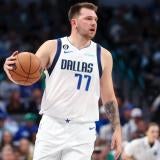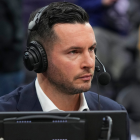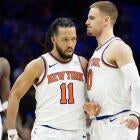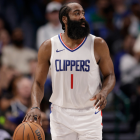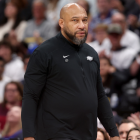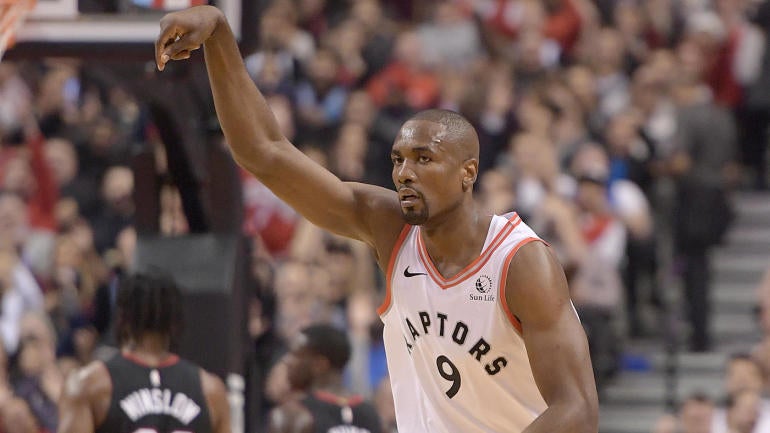
Two days into free agency, most of the big names are off the board. This does not include Bogdan Bogdanovic, which is amusing because on Monday it looked like he wasn't going to really hit the market.
As a follow-up to my Day 1 takeaways, here are seven thoughts about Day 2:
Another big deal in L.A.
Serge Ibaka took the MLE (two years, $19 million) to reunite with Kawhi Leonard, perhaps the most difference-making move any contender has made this offseason. The contrast with Montrezl Harrell is unavoidable, so let's just get to it: They're both bargains at this (identical) salary, but Ibaka fits much better with the Los Angeles Clippers. Ibaka would've fit better with the Los Angeles Lakers, too.
Harrell had beautiful chemistry with Lou Williams on the second unit, and he can develop something similar with Dennis Schroder. Opponents will attack him and Schroder defensively in the playoffs, though, the same way they went at him and Williams. The 31-year-old version of Ibaka isn't the vertical spacer that Harrell is, and he's not the same kind of threat with the ball in his hands, either. He's a vastly superior defender, though, and his shooting is a game-changer in the most literal sense.
Ibaka allows the Clippers to play five-out the way JaMychal Green did, without sacrificing size and rim protection. He is not the dominant shot blocker he was in his Thunder days, but his skills and feel have improved since then. While he needn't replace Ivica Zubac as a starter, he will surely close some playoff games. Ibaka and Marc Gasol had a similar platoon system with the Toronto Raptors.
One of the reasons the Raptors won a championship in 2019 and remained so resilient post-Kawhi is that they didn't have to play anybody who couldn't shoot 3s or couldn't hold his own on defense. The Clippers are not quite there, but they're more versatile and less vulnerable in a playoff setting now that Ibaka is in Harrell's spot.
Another side to the Hayward story
I'm not going to pile on the Charlotte Hornets for overpaying Gordon Hayward. My colleague Sam Quinn has already lit them on fire, and you probably don't need me to explain why a team in their position shouldn't spend $120 million on a 30-year-old with this injury history. Take the price tag out of it for a minute, or even imagine if Charlotte were paying him something like $9 million per season instead of $30 million.
Purely in terms of team need, Hayward helps the Hornets. Through several front offices and head coaches -- and a name change! -- this is a franchise has spent most of the last decade searching for a wing player with his skill set. Remember the Lance Stephenson debacle? How about the absolute revelation that Nicolas Batum seemed to be before he got paid? Hayward can create shots and space the floor, so defenses always have to account for him. Even more than his scoring, his passing will help LaMelo Ball, Miles Bridges and P.J. Washington.
Hayward wouldn't have left Boston, however, just to be the guy who makes the offense more organized. The Celtics initially recruited Hayward to be their best player, coming off a season in which he had a usage rate of 26.9 percent, slightly higher than Kemba Walker's this past season. Through no fault of his own, he turned into a 20-percent-usage guy. Every once in a while, he'd have a big scoring night, but that wasn't his job. While going to Charlotte is not the same as going back to the Utah Jazz of four years ago, he'll have a chance to show he can still fill it up.
Let's see it.
(One caveat: As presently constituted, the Hornets don't actually have that much room for Hayward to stretch himself. I'm assuming that the roster won't include all four of Hayward, Ball, Devonte' Graham and Terry Rozier when the season starts.)
The Heat pulled it off
Strictly speaking, the Heat are not running it back, since they have replaced Jae Crowder and Derrick Jones Jr. with Moe Harkless (one year, $3.6 million) and Avery Bradley (two years, $11.6 million, with a team option). Miami has, however, done what it set out to do: Retain Goran Dragic (two years, 37.4 million, with a team option) and stay a contender without sacrificing its 2021 flexibility.
The Heat might've even improved. As versatile as the Heat were on defense last season, they never had anybody to disrupt point guards at the point of attack. Now they have Bradley, whose best attribute is just that. In Miami's system, he'll get his share of layups as a cutter, too.
One of the luxuries of having an elite coach like Erik Spoelstra is that you can trust that he'll mix and match his lineups as necessary in a playoff series. Bradley gives him another kind of defensive weapon, one that can be crucial against stars.
Spoelstra will need to deploy Harkless selectively, too, since he's a less willing and less accurate shooter than Crowder. Opponents ignored him on the perimeter when he was with the Portland Trail Blazers, and Jones barely played in the playoffs for the same reason. Harkless came much cheaper than Crowder, though, and his length and foot speed make him a defensive upgrade in certain matchups.
Miami has 15 players under contract, but it might not be done. It has a trade exception worth $7.5 million, a figure just low enough to avoid the luxury tax. The $3.6 million bi-annual exception is still available, too, should the Heat decide to split the MLE between Bradley and Harkless. And since most of their players are effectively on expiring contracts, they will have opportunities to add reinforcements at the trade deadline.
The win-now Suns strike again
Crowder jumped to the Phoenix Suns on a three-year, $30 million deal, and while his production has varied from team to team, there's no reason to expect he'll be any less effective than he was in Miami. Phoenix was under the radar for the months between its hot start and its bubble run, but it ran a pretty, Heat-esque offensive system the entire time. That is Crowder's preferred environment, and his presence will give the Suns a more Miami-like mix of veterans and young players.
Hours after the Crowder addition, Phoenix came to terms with another tough customer: Jevon Carter will re-sign for three years and $11.5 million, which is highway robbery if his 42.5-percent 3-point shooting wasn't a fluke. It's impossible not to love Carter's defense, and the 6-foot-1 guard is sturdy enough that the Suns should be able to get away with playing him next to Chris Paul, the same way Raptors use Kyle Lowry and the newly history-making Fred VanVleet. If Carter, Cameron Payne and still-unsigned restricted free agent Dario Saric click this season like they did in Orlando, Phoenix's could have one of the league's better second units, with either Crowder or Cameron Johnson playing stretch 4.
Brooklyn fills a longstanding hole
For a team that used Quincy Acy, Trevor Booker, Luis Scola, Anthony Bennett, Andrew Nicholson, Justin Hamilton, Dante Cunningham, Timofey Mozgov and Tyler Zeller as stretch 5s in the 2016-17 and 2017-18 seasons, the Brooklyn Nets have been surprisingly devoid of them since. (Yes, I promise you, Mozgov and Zeller were encouraged to shoot 3s in Brooklyn. I was there.)
When backup center Ed Davis got injured against the Philadelphia 76ers in the 2019 playoffs, Jared Dudley and Rondae Hollis-Jefferson stepped in to play smallball 5, but Dudley provided only a marginal stretchiness and Hollis-Jefferson provided none. This past season, the Nets platooned Jarrett Allen and DeAndre Jordan in the middle, and the skinny Rodions Kurucs drew backup center duty when they were without Jordan in the bubble. Beyond the reunion with Kevin Durant, this is why Brooklyn's veteran-minimum deal with Jeff Green is significant.
The 34-year-old Green couldn't find his place with the Jazz last season, but became a crucial part of the rotation after he landed with the Houston Rockets. In Houston, Green realized his late-career destiny as a center, switching and shooting 3s more frequently than ever before.
If both Jordan and Allen are still around, the Nets won't ask Green to play nearly as much center this season. He gives them the option to play five-out, though, and his role won't be that much different if he's standing in the corner playing power forward. Green's work with the Rockets showed exactly how he can complement Durant, Kyrie Irving and whoever else is making plays.
There has been tons of noise about Brooklyn trying to trade for a third superstar. Much like the other team linked to James Harden, though, the Nets don't have to do a blockbuster for their offseason to be successful. Green and fellow newcomers Landry Shamet and Bruce Brown have games tailor-made to support stars. And while it might've seen like a fait accompli, ponying up to keep Joe Harris (four years, $75 million) deserves applause, too.
In praise of the Grizzlies
Memphis is sneaky. The front office that keeps stealing good players in the draft has also retained its young players on favorable contracts. De'Anthony Melton's four-year, $35 million deal is probably my favorite of the entire offseason, and keeping John Konchar for $9 million over four years might end up being a bigger steal. (It is unclear as of yet if there are any options or non-guaranteed years on Konchar's contract.)
Melton, a 6-2 combo guard with a 6-8 wingspan, makes up for his shaky shooting with stifling defense, reliable passing and ridiculous rebounding for his height. Konchar, a 6-7 wing, has only a fraction of Melton's NBA experience, but is just as much of an analytics darling. Clichés like "winning player" and "glue guy" don't capture the Konchar experience, but they apply: He is always hustling and always making good decisions, and makes plays on both ends without being the center of attention on either of them. Don't be shocked if this mostly anonymous player earns a spot in the Grizzlies' rotation and establishes himself as a high-level role player.
Konchar and Melton were both restricted free agents. I'm surprised these contracts were enough to prevent them from signing offer sheets elsewhere.
Sink or swim in Atlanta
After adding Danilo Gallinari (three years, $61.5 million) on the first day of free agency, the Hawks reached agreements with Kris Dunn (two years, $10 million with a player option), Rajon Rondo (two years, $15 million) and still have around $20 million of cap space.
The Hawks could theoretically add Bogdanovic and/or move John Collins for a wing, or they could be more or less finished. Regardless, it seems like it's going to be sink-or-swim time for their young wings.
While Kevin Huerter should remain a fixture in Atlanta's rotation, there will be fewer backcourt minutes available now that Rondo and Dunn are around. As far as Cam Reddish and De'Andre Hunter are concerned, the free playing time they got as lottery picks on a rebuilding team should be a thing of the past, and they will likely be directly competing with each other.
Ideally, this will be healthy for their development, as will the heightened expectations and the experience of playing in meaningful games. When people like me urge teams like the Hawks to be more patient, these kind of things often go unsaid.
For more on the offseason player movement: CBS Sports' free-agent tracker.








